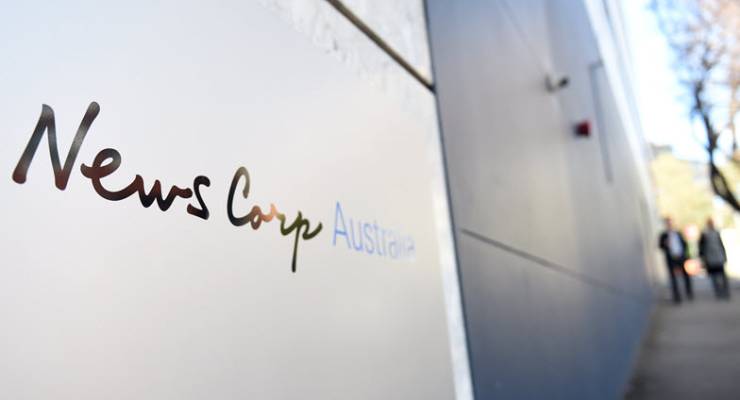
There is something about News Corp’s just-released figures for the financial year that feels like the end of an era — the end of the print era in Australian news.
Instead, what we can see is that News Corp is morphing into a real estate sales company that, for the time being, supports a news business on the side. A lot like Fairfax, really.
Maybe it was the brutal honesty of the new global CFO Susan Panuccio, warning that this financial year will bring a repeat of the $40 million in cuts to the Australian papers. Those are the cuts that in the recent financial year gutted News’ famous photographic teams and slashed the editing teams.
Here’s the quote from Panuccio that will shape News in Australia over the next six months: “We’re continuing our assessment of the cost structure at News Australia … it is clear more work needs to be done, particularly given our reliance on print in that market.”
[Now it’s News’ turn to swing redundancy axe]
“Reliance on print”, from a company that has consistently talked up the future of print, that has attacked its competitors for suggesting the dangers of relying on print, and that, if truth be told, pushed out its local CEO in 2013 for demonstrating an insufficient taste for the print Kool-Aid.
It was left to The Australian headline (in print) to give it a positive spin: “News Corp papers maintain their digital momentum”. Mmm … momentum. Roll that word around your mouth. Try to take that to the bank.
As everyone in the industry knows, “digital momentum” is the fig leaf that covers up print decline.
This is not to discount the importance of digital. If anything, News Corp has been a lead innovator. There’s a lot of people inside the company trying to make things work.
News Corp only releases figures on a global basis with revenue broken into broad segments. So its reported revenues from “News and Information Services” includes both print and digital advertising and subscription revenues from its UK papers (The Times and The Sun) and The Wall Street Journal and associated services, as well as its Australian papers.
Based on bits and pieces released by the company over the years and reports from leaked internal documents in 2013 published in Crikey, we can estimate that its Australian operations last year generated revenues of about $1.4 billion, about two-thirds of its revenues five years ago.
We don’t know the breakdown between print and digital revenues, but let’s assume based on industry trends somewhere around an 80-20 split. It’s improving over time. Year on year, digital revenues are up while print revenues fall. But despite the digital momentum, most revenues still come from print — and they’re falling a whole lot faster than digital revenues are rising.
Now let’s throw the trend lines forward a few years: we can guesstimate that within four or five years News Corp’s print news revenues will be somewhere around $500 million, maybe $600 million.
This undermines the core business strength of newspapers: high fixed costs (which keeps out competitors) and low variable costs (which means lots of profit). Knowing this, all media companies have been managing the revenue decline by cutting costs year on year to keep the cost curve under the revenues line.
[News Corp chair’s (unintentionally) hilarious speech to the Melbourne Press Club]
News Corp — being effectively a privately owned company — has been better at managing the politics of this than a company with a broad-based shareholding. It hasn’t had to feed the stock market with cost-cutting lollies to keep shareholders happy the way Fairfax has. Panuccio’s quote shows us that the company can’t pretend anymore.
In fact, these latest figures tell us the falling revenue line is close to crashing through the fixed costs floor that sustains print. In other words, the economic model of newspapers is hitting the boundary of what economists would call Stein’s law: If something can’t go on forever, it won’t!
News Corp has long been prepared to sustain loss making or break even ventures to suit its broader agenda. It’s kept papers alive longer than a harder nosed business may have. That’s been great for journalism in general, and for Australia in particular. The leaked internal documents from 2013 suggested that their Australian news operations as a whole were even then pretty marginal from a business point of view, and it’s hard to see how much would have improved since then.
The bright star in the News Corp figures has nothing to do with news. It’s the digital real estate business, dominated by its majority ownership in the REA Group Ltd in Australia and Move in the US.
This segment generated about 12% of News Corp revenues, but 40% of profits (EBITDA). It’s likely that these real estate revenues are now more than the revenues from the Australian print operations – with a much lower cost. And if they weren’t more last year, they will be this year, and every year after that.
Cross-subsidisation exists within all companies of any size. But unless there is a compelling business for it, Stein’s law again comes into play. For the past five years the case for the real estate digital business subsidising news has been sufficiently compelling to continue. But for how much longer?








Only a journalist or a billionaire could say News Corp’s print survival has been ‘great for journalism in general, and for Australia in particular’.
The News papers are propaganda rags, not quality newspapers, and News is arguably the most regressive and damaging political and social force in Australia. The slide of Australia into paranoia and a police state will be their epitaph.
Agree, doubleplus.